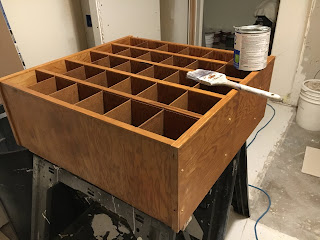A couple of hundred years ago, when the restaurant was a hub for the scholastic neighborhood, regular patrons would supply their own cloth napkins. Between meals, the patron would stash his or her napkin in the assigned napkin cubby, a nicety of the modest dining establishment that allowed a flair of sophistication for the meal. The stacked rows of cubbies provided convenient storage, and the little doors, and the camaraderie of the clientele, provided assurance that your napkin would be waiting for you at the next meal.
I was enchanted. So, of course, Haven West has its own napkin cubby.
 |
| Napkin cubby |
It's a cute little thing, and it has its own story. But before I tell you that story, perhaps I should explain my preoccupation with cloth napkins.
When I was in high school, way back in the 70s, our principal hired a new history teacher who also taught ecology. No one had heard the term before, but here he was, and he managed to teach all of us the concept of the environment and our role in it. Our senior class project was to plant trees. We knocked on doors throughout the neighborhoods belonging to our high school and asked the homeowners if they would like to have a new tree planted in their parking strip, free of charge.
The city provided the trees and sent a tree-hole digger to all of the addresses where people had said, "Yes, please!" For a few Saturdays in the early spring, me and my classmates roamed the streets and planted the waiting trees into their waiting holes. Mr. Hicks single-handedly launched the environmental movement in the former-orchard city of San Jose, CA.
Needless to say, the concept of ecology and environment made a huge impression on me. And so, when I moved into my first apartment the day after high school graduation, one of the first things I did was to make cloth napkins. I had just helped plant 500 trees. Now my job was to reduce the number of trees that were being cut down to make paper. Cloth napkins helped me do that.
 |
| Napkins in Waiting |
Fast forward fifty years; I'm still making cloth napkins, and I've persuaded the Haven West household to use them. Our visitors use them, too.
But if you have to wash, dry, fold, and replenish all the napkins after every meal, it becomes tedious, people lose interest, and paper napkins start to creep into daily routines.
Enter the memory of the antiquated, Parisian restaurant with its stacked rows of napkin cubbies. We needed napkin cubbies.
Enter the furniture sale at Living Wisdom School. When first I saw the mailboxes needing a new home, mailboxes that most likely used to live in the school office, I thought it might be useful to stash things for people living in our house as well as houses on the rest of the farm. Forgotten sunglasses and clippers could find safe, temporary lodging in this stack of convenient mailboxes. So Dambara and I brought it home.
 |
| Drab, brown, plywood mailboxes |
It happened to be the drab brown that old wooden furniture tends to attain, without the beauty of fine wood shining through. It was drab, brown plywood. But! we had paint.
 |
| Primed cubbies and hand, as it turned out |
 |
| Cheerful, leftover paint |
Enchanted.
So, we have a napkin cubby, with pretty cloth napkins, and everyone enjoys this tiny notch in the crusade to save trees.
Mr. Hicks would be so proud.
 |
| Enchanting napkin cubby |




No comments:
Post a Comment